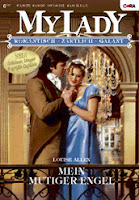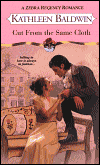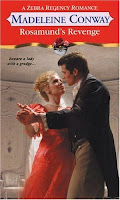1) Tell us about Scandal’s Daughter! What inspired this book?
First of all, thank you ladies for having me on Risky Regencies. I love this blog! To answer your question, in Scandal’s Daughter, Sebastian, Earl of Carleton, promises his dying godfather he will find a husband for his childhood friend in three months or marry her himself. Sebastian quickly becomes the most determined matchmaker in England.
Gemma is the daughter of a notorious femme fatale. She doesn’t believe any respectable man will marry her, so she chooses to run her grandfather’s estate rather than enter the matrimonial mart. Her entire identity is bound up in being the honorary Squire. But her grandfather wants her married and provided for before he dies and he hires a land agent to take over Gemma’s duties. She desperately wants to regain her position on the estate, but in the meantime, Sebastian comes back into her life and she’s torn. I think what inspired me to write this book, though I didn’t know it at the time, was a similar upheaval in my own life. I recognized at the start of my marriage that I couldn’t continue as a corporate lawyer working crazy hours and bring up my children the way I wanted. Thus, a career as a writer was born! But so much of my identity was bound up in my career as a lawyer, it was a real struggle for me to come to terms with not having that any more. I learned that it’s who you are inside, not what you do, that counts. And I hope that’s what my heroine learns along the way, too.
2) We’ve heard you’re a great researcher! Were there any challenges in researching for this book? Any new or suprising historical facts you discovered?
Oh, where did you hear that? LOL Most of my research never makes it into a book. I try very hard to get the details right and I love delving into etymology–the history of words. All sorts of things came up in Scandal’s Daughter. For instance, I intended at first to base my heroine’s mother on Jane Digby, an intrepid Lady of Quality who never really fitted into London Society and ended up running away, eventually marrying a Bedouin prince. So I read about her fascinating life, but then I decided I wanted this wonderful character on stage, so I brought Sybil back from her travels (witha toy-boy in tow!) and she plays a significant role in the book. And there are always a myriad small details, like whether Japanese porcelain had entered England at the time my book was set, to the history of medieval stained glass.
3) What are some of your favorite sources?
Online, I love the Georgian Index http://www.georgianindex.net/fd/index.html#TOPand I use the UK National Trust site a lot to scope out locations:http://www.nationaltrust.org.uk/main/w-vh/w-visits/w-findaplace.htm I have a good library of reference books which I’m adding to all the time. One I absolutely love is ‘Regency Style’ by Steven Parissien, which my wonderful writer friend Anna Campbell gave me. It’s visually stunning, and goes through a Regency house, item by item. It has sections devoted to staircases and wallpaper and bathrooms, so it’s incredibly useful. I regularly use Debrett’s ‘The Stately Homes of Britain’ and Carolly Erickson’s ‘Our Tempestuous Day’. I always read the background on the year in which my book is set in OTD before I begin, so I’m aware of any political or social issues that might affect my characters as the story unfolds.Still, there’s never enough time for research!
4) Tell us what’s “risky” or different from the norm about this book!
Gemma and Sebastian actually discuss the possibility of pregnancy before they make love the first time. And Gemma uses contraception, so I thought that was pretty risky! I’d seen so many romances where the couple fall into bed with no thought for the consequences that I wanted to do something different. I was worried an editor might want me to take it out, but my editor is very cool and didn’t even mention it. However, I don’t mean to criticize books where the heroine is swept away by passion. Of course, it happened all the time! I just relate a lot more to someone who does worry about the consequences and takes care of them as far as she can, given the circumstances and the era. It wouldn’t work in every book, but the discussion actually heightened the conflict in Scandal’s Daughter, so I felt justified putting it in.
5) What is it about the Regency that attracts you,makes you want to set your books in it?
Undoubtedly, it’s the wit. I’ve always loved that dry English sense of humour, the banter between hero and heroine that works so well in the Regency setting. And I love the subtext–all the things the characters can’t say but they can imply a great deal by their actions and what they do say,which is always fun for a writer.
6) What’s it like living in Australia? Is there a large romance community there?
I love Australia. I’m absolutely passionate about our wonderful lifestyle. I’m a real beach girl, so it’s great to be an hour’s drive from some of the best beaches in the world. The romance community here is not large by US standards, but the romance writing community is incredibly tight and supportive. There’s no spite or overt jealousy (or if there is, I’ve never come across it). I think it’s a lot to do with our veteran members, who are endlessly patient with newcomers and do so much to assist fledgling writerswith their careers. Authors like Anne Gracie and Trish Morey set the tone,and I’m very grateful for that.
7) Tell us what’s next for you!
My next book is currently scheduled for September 2008. It’s another Regency-set historical, about a duke who accidentally steals a lady’s erotic diary. It’s set against a background of political upheaval, when Liverpool declared a state of emergency and people were being locked up without trial for sedition. My heroine’s brother is a country vicar thrown in jail for aiding suspected arsonists. She threatens to expose government secrets by publishing her diary if the authorities don’t release him. My hero, the duke, steals what he thinks is that diary, only it turns out to contain the heroine’s secret erotic fantasies. I had a lot of fun with that one!
Be sure and comment on Christine’s post for a chance to win an autographed copy of Scandal’s Daughter! Winner will be announced Monday…





















